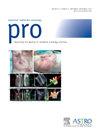在放射肿瘤信息系统中使用参考点汇总纵向剂量数据的最佳实践指南。
IF 3.5
3区 医学
Q2 ONCOLOGY
引用次数: 0
摘要
目的/目标:由于来自不同供应商的电子系统各不相同,在放射肿瘤学中跟踪患者剂量具有挑战性。治疗计划系统(TPS)、放射肿瘤信息系统(ROIS)和电子健康记录(EHR)缺乏统一性,使剂量跟踪和报告变得复杂。为了解决这个问题,我们研究了多个放射肿瘤学机构的做法,并提出了当前系统的指导原则:我们对不同专业团体的成员进行了调查,以了解 TPS、ROIS 和 EHR 系统中的剂量报告实践。目的是确定一致的组成部分并制定指南:结果:我们确定了六种治疗方案,在这些方案中,目前的 ROIS 默认值无法准确表示剂量总量。为了解决这些问题,我们提出了一种涉及三种参考点类型(主要治疗计划参考、剂量检查和处方跟踪)的标准化方法。此外,还建议对参考点进行标准化命名,以便于与电子病历集成。这种方法只需对现有系统进行最低限度的修改,并能更方便地在电子病历中传输和显示数据:结论:商业 TPS 和 ROIS 中参考点的标准化可以弥补基础设施的不足,改善复杂临床情况下的剂量跟踪。这种标准化与 AAPM 的 TG-263 保持一致,为持续开发自动化、标准化、可互操作的工具铺平了道路,从而提高了共享参考点信息的便利性。本文章由计算机程序翻译,如有差异,请以英文原文为准。
Best Practice Guidelines for Use of Reference Points in Radiation Oncology Information Systems to Aggregate Longitudinal Dosimetric Data
Purpose
Tracking patient doses in radiation oncology is challenging because of disparate electronic systems from various vendors. Treatment planning systems (TPS), radiation oncology information systems (ROIS), and electronic health records (EHR) lack uniformity, complicating dose tracking and reporting. To address this, we examined practices in multiple radiation oncology settings and proposed guidelines for current systems.
Methods and Materials
A survey was conducted among members of various professional groups to understand dose reporting practices in TPS, ROIS, and EHR systems. The aim was to identify consistent components and develop guidelines.
Results
We identified 6 treatment scenarios where current ROIS defaults fail to accurately represent dose totals. A standardized approach involving 3 reference point types – primary treatment plan reference, dose check, and prescription tracking – was proposed to address these scenarios. Standardizing naming conventions for reference points was also recommended for easier integration with EHRs. The approach requires minimal modifications to existing systems and facilitates easier data transfer and display in EHRs.
Conclusions
Standardizing reference points in commercial TPS and ROIS can bridge infrastructure gaps and improve dose tracking in complex clinical scenarios. This standardization, aligned with the American Association of Physicists in Medicine's Task Group (TG) 263, paves the way for continual development of automated, standardized, interoperable tools, enhancing the ease of sharing reference point information.
求助全文
通过发布文献求助,成功后即可免费获取论文全文。
去求助
来源期刊

Practical Radiation Oncology
Medicine-Radiology, Nuclear Medicine and Imaging
CiteScore
5.20
自引率
6.10%
发文量
177
审稿时长
34 days
期刊介绍:
The overarching mission of Practical Radiation Oncology is to improve the quality of radiation oncology practice. PRO''s purpose is to document the state of current practice, providing background for those in training and continuing education for practitioners, through discussion and illustration of new techniques, evaluation of current practices, and publication of case reports. PRO strives to provide its readers content that emphasizes knowledge "with a purpose." The content of PRO includes:
Original articles focusing on patient safety, quality measurement, or quality improvement initiatives
Original articles focusing on imaging, contouring, target delineation, simulation, treatment planning, immobilization, organ motion, and other practical issues
ASTRO guidelines, position papers, and consensus statements
Essays that highlight enriching personal experiences in caring for cancer patients and their families.
 求助内容:
求助内容: 应助结果提醒方式:
应助结果提醒方式:


